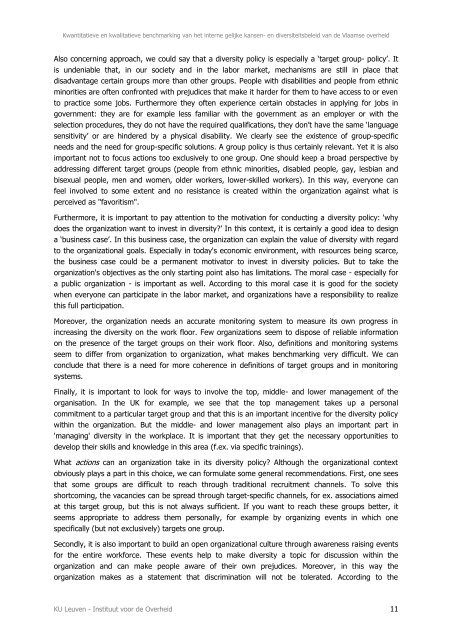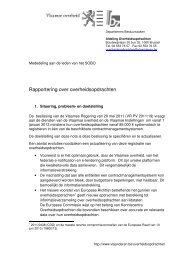Lees hier het rapport van deze kwantitatieve en ... - Bestuurszaken
Lees hier het rapport van deze kwantitatieve en ... - Bestuurszaken
Lees hier het rapport van deze kwantitatieve en ... - Bestuurszaken
You also want an ePaper? Increase the reach of your titles
YUMPU automatically turns print PDFs into web optimized ePapers that Google loves.
Kwantitatieve <strong>en</strong> kwalitatieve b<strong>en</strong>chmarking <strong>van</strong> <strong>het</strong> interne gelijke kans<strong>en</strong>- <strong>en</strong> diversiteitsbeleid <strong>van</strong> de Vlaamse overheid<br />
Also concerning approach, we could say that a diversity policy is especially a ‘target group- policy’. It<br />
is und<strong>en</strong>iable that, in our society and in the labor market, mechanisms are still in place that<br />
disad<strong>van</strong>tage certain groups more than other groups. People with disabilities and people from ethnic<br />
minorities are oft<strong>en</strong> confronted with prejudices that make it harder for them to have access to or ev<strong>en</strong><br />
to practice some jobs. Furthermore they oft<strong>en</strong> experi<strong>en</strong>ce certain obstacles in applying for jobs in<br />
governm<strong>en</strong>t: they are for example less familiar with the governm<strong>en</strong>t as an employer or with the<br />
selection procedures, they do not have the required qualifications, they don’t have the same ‘language<br />
s<strong>en</strong>sitivity’ or are hindered by a physical disability. We clearly see the exist<strong>en</strong>ce of group-specific<br />
needs and the need for group-specific solutions. A group policy is thus certainly rele<strong>van</strong>t. Yet it is also<br />
important not to focus actions too exclusively to one group. One should keep a broad perspective by<br />
addressing differ<strong>en</strong>t target groups (people from ethnic minorities, disabled people, gay, lesbian and<br />
bisexual people, m<strong>en</strong> and wom<strong>en</strong>, older workers, lower-skilled workers). In this way, everyone can<br />
feel involved to some ext<strong>en</strong>t and no resistance is created within the organization against what is<br />
perceived as "favoritism".<br />
Furthermore, it is important to pay att<strong>en</strong>tion to the motivation for conducting a diversity policy: 'why<br />
does the organization want to invest in diversity?’ In this context, it is certainly a good idea to design<br />
a ‘business case’. In this business case, the organization can explain the value of diversity with regard<br />
to the organizational goals. Especially in today's economic <strong>en</strong>vironm<strong>en</strong>t, with resources being scarce,<br />
the business case could be a perman<strong>en</strong>t motivator to invest in diversity policies. But to take the<br />
organization's objectives as the only starting point also has limitations. The moral case - especially for<br />
a public organization - is important as well. According to this moral case it is good for the society<br />
wh<strong>en</strong> everyone can participate in the labor market, and organizations have a responsibility to realize<br />
this full participation.<br />
Moreover, the organization needs an accurate monitoring system to measure its own progress in<br />
increasing the diversity on the work floor. Few organizations seem to dispose of reliable information<br />
on the pres<strong>en</strong>ce of the target groups on their work floor. Also, definitions and monitoring systems<br />
seem to differ from organization to organization, what makes b<strong>en</strong>chmarking very difficult. We can<br />
conclude that there is a need for more coher<strong>en</strong>ce in definitions of target groups and in monitoring<br />
systems.<br />
Finally, it is important to look for ways to involve the top, middle- and lower managem<strong>en</strong>t of the<br />
organisation. In the UK for example, we see that the top managem<strong>en</strong>t takes up a personal<br />
commitm<strong>en</strong>t to a particular target group and that this is an important inc<strong>en</strong>tive for the diversity policy<br />
within the organization. But the middle- and lower managem<strong>en</strong>t also plays an important part in<br />
'managing' diversity in the workplace. It is important that they get the necessary opportunities to<br />
develop their skills and knowledge in this area (f.ex. via specific trainings).<br />
What actions can an organization take in its diversity policy? Although the organizational context<br />
obviously plays a part in this choice, we can formulate some g<strong>en</strong>eral recomm<strong>en</strong>dations. First, one sees<br />
that some groups are difficult to reach through traditional recruitm<strong>en</strong>t channels. To solve this<br />
shortcoming, the vacancies can be spread through target-specific channels, for ex. associations aimed<br />
at this target group, but this is not always suffici<strong>en</strong>t. If you want to reach these groups better, it<br />
seems appropriate to address them personally, for example by organizing ev<strong>en</strong>ts in which one<br />
specifically (but not exclusively) targets one group.<br />
Secondly, it is also important to build an op<strong>en</strong> organizational culture through awar<strong>en</strong>ess raising ev<strong>en</strong>ts<br />
for the <strong>en</strong>tire workforce. These ev<strong>en</strong>ts help to make diversity a topic for discussion within the<br />
organization and can make people aware of their own prejudices. Moreover, in this way the<br />
organization makes as a statem<strong>en</strong>t that discrimination will not be tolerated. According to the<br />
KU Leuv<strong>en</strong> - Instituut voor de Overheid 11

















